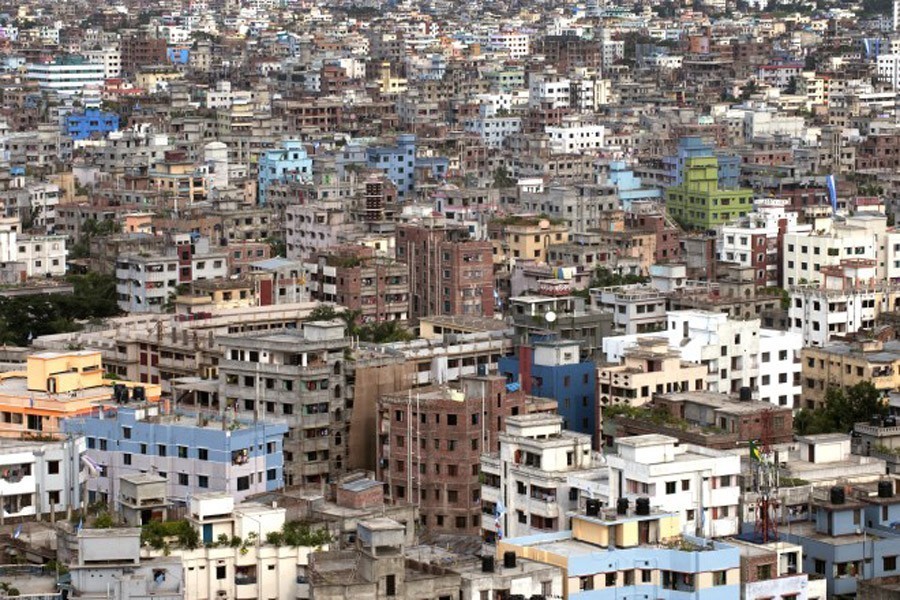
Published :
Updated :

Being able to climb a liveability listing just one notch up cannot elate the residents of a 400-year-old city, like Dhaka. Nor has Dhaka longedfor such a sudden 'graduation' after being made to remain stuck in a pitiable position for long. In spite of its pollutions, occasional rise in the spate of crimes and traffic gridlocks, and the compulsively defiant jaywalking, Dhaka used to organise art biennales, music, theatre and open-air poetry festivals, Bangla New Year carnivals etc in the pre-pandemic times. But the city remains caught in an inescapable maze in which any noticeable promotion to an upper position proves virtually a pipedream. This year's global annual survey conducted by EIU (the Economist Intelligence Unit) has found Dhaka to be the fourth least liveable city in the world. The position of Dhaka, as has been ranked by EIU, is 137th among 140 countries in the current year. The Bangladesh capital was placed at the third in the liveability index in 2019, and judged the second-worst in 2018.
Given the major areas considered for making the city's placements include culture and environment, education and infrastructure, Dhaka's miserable position in the index makes many baffled. With a fast-growing city on the verge of seeing a number of mega infrastructure projects in the execution phase, notably in the communication sector, its placement at the 137th position among 140 world cities fills Dhaka-lovers with incredulity. This is really a conundrum that all the past achievements and glories of a city under review get wiped out when new criteria are picked in judging its liveability. The 75-year-old EIU liveability index might consider the options for 'pass marks', instead of declaring poorly performing cities outright failures.
Had not the nearly catastrophic Covid-19 pandemic put the whole world in disarray, the rankings in the EIU liveability survey of cities would have presented a traditional scenario. It would have a few north and west European countries, as well as one or two East and Southeast Asian capitals in the upper rung. As part of a hackneyed picture, South Asian and the strife-torn Sub-Saharan African cities would have found themselves stuck up in their same old dreadful places. As shown by the 75th global survey of cities by the Economist Intelligence Unit (EIU), a number of countries around the world have changed places. As for example, the Hawaii capital Honolulu has emerged the biggest gainer on the index. It has moved up 46 places finishing 14th --- thanks to its efforts to contain the spread of Covid-19 as well as its prompt start of vaccination. Other cities demonstrating remarkable progress include Taipei with the 33rd place and Singapore finishing at 34th.
To the bafflement of many, a few pandemic-struck European cities fared relatively poor this year on some criteria. It resulted in the fall in their ranks, observed Simon Baptist, global chief economist at the EIU. The worldwide liveability index ranks 140 cities on a range of factors.
Coming to the position of Dhaka, perennially a laggard, it has had to remain content with its 4th position in the current year's EIU liveability survey. The Bangladesh capital finds itself this year just one mark up from its third position in the least liveable city survey in 2019. The EIU's global liveability index ranks the cities basing on more than 30 factors. They are qualitative and quantitative in character covering five broad categories. Those include political and social stability, crime, education and infrastructure, culture and environment and access to health care. To elucidate the Bangladesh case, Dhaka has been ranked 137th with 33.5 points. It has scored 55 in stability, 16.7 in health care, 30.8 in culture and environment, 33.3 in education, and 26.8 in infrastructure.
It's amazing to find that amid the corona pandemic of varying intensities, the metropolitan city of Auckland in New Zealand has been picked by EIU as globally the most liveable city. According to the survey, Auckland's foremost position stems from the city's successful handling of Covid-19. The city has allowed schools, theatres, restaurants and other cultural attractions to keep open during the survey period from February 22 to March 21, 2021. In the EIU 2021 survey, the Asia-Pacific cities dominated the top 10 rankings, even as the pandemic led to remarkable liveability declines around the world. European cities are conspicuous by their absence, a factor which hasn't eluded the attentive EIU watchers. The top 10 cities under the Global Liveability Index 2021 are Auckland (New Zealand), Osaka (Japan), Adelaide (Australia), Wellington (New Zealand), Tokyo (Japan), Perth (Australia), Zurich (Switzerland), Geneva (Switzerland), Melbourne (Australia), and Brisbane (Australia). The list of the countries amply shows the poor representation of Europe and North America. It is viewed by many as a big shift from the traditional trend in such findings. However, with the onslaught of Covid-19 pandemic weakened through health protocols and stronger vaccination drives, the global situation is expected to revert to its earlier scenario. The index has come up with a significant feature vis-à-vis the changes in the position of cities in an almost static list. The pandemic has, visibly, unleashed a mess-up. On the other hand, due to the pandemic the EIU has added new indicators to the survey. They include stress on health care resources as well as restrictions around local sporting events, theatres, music concerts, restaurants and schools.
Amid the delight of recreation aficionados, and the lately available taste of freedom, better scoring cities can now realise the benefits of following corona restrictions. Bangladesh should assess its performance in this critical test.


 For all latest news, follow The Financial Express Google News channel.
For all latest news, follow The Financial Express Google News channel.